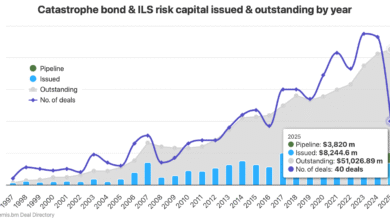Terrorism risk could gain further traction in the cat bond market: Man Group

As the catastrophe bond market continues to evolve, the inclusion of non-natural catastrophe risks like terrorism could become increasingly appealing to insurance-linked securities (ILS) investors seeking to optimise their portfolios, according to Man Group.
While traditional cat bonds have primarily focused on natural catastrophe events like hurricanes and earthquakes, the inclusion of non-natural catastrophe risks, such as terrorism, cyber threats, and pandemics, has been a more recent development that’s been seen across the cat bond market.
UK reinsurer Pool Re sponsored the first standalone terrorism risk catastrophe bond in 2019, when the company first ventured to the cat bond market in search of retrocessional reinsurance protection for UK terror attack losses in 2019, with a UK £75 million (approx. US $97 million at the time) Baltic PCC Limited (Series 2019) transaction.
Then in 2022, Pool Re ventured back to the cat bond market to sponsor it’s Baltic PCC Limited (Series 2022-1) terror catastrophe bond, which the firm managed to upsize to £100 million in size.
Then in November 2024, GAREAT, a co-reinsurance pool created for the ceding of compulsory terrorism insurance cover provided in France, entered the catastrophe bond market for the first time with its Athéna I Reinsurance DAC cat bond.
This marked just the third terrorism risk cat bond to ever come to the market, with the previous two being the Baltic transactions issued for Pool Re.
Finally, just in recent weeks and since Man’s report was published, the anticipated third Baltic PCC Limited (Series 2025-1) terrorism cat bond for Pool Re was priced and finalised, securing another £100 million of retrocessional protection for the company from the capital markets.
So, it’s important to remember, that terrorism catastrophe bonds are still a relatively new and emerging segment within the ILS market, but one some investors are welcoming for the diversification these issuances can provide.
Man Group highlighted, that so far, only UK and French terrorism exposure is accessible through the catastrophe bond market.
However, there are more than a dozen terrorism pools throughout the world, with the bulk able to purchase cover in the private market. Therefore, over time, it is possible that the terrorism cat bond geographical scope will increase, the investment manager added.
“Man-made risks, such as cyber and terrorism, do differ from natural catastrophes. For man-made risks, insurers are able to take action to reduce policyholder risk. In the case of cyber this may be performing an audit of the policyholder’s computing infrastructure, while for terrorism Pool Re offers a variety of programmes and tools aimed at incentivising good security and risk management behaviours,” Man Group commented.
Furthermore, the investment management firm notes that pure terrorism risk, as embodied by both the Baltic PCC and Athéna deals, “is obviously a diversifier to natural catastrophe bonds”, but a concern might be that a major terrorism event (and subsequent cat bond losses) could be correlated to a sell-off in financial risk assets.
However, as Man Group explains, there are several counterarguments to this perspective, with one being how there are only low hundreds of millions of cat bonds outstanding linked to terrorism, which represents just a small percentage of the overall cat bond market capitalisation, while peak perils such as US wind and quake, heavily dominate the space.
“Catastrophe bonds support their issuers (usually governments and insurers) with the promise of an insurance payment during an extreme tail risk event. As such, they ideally mitigate – at least – the financial and social impact of such a disaster,” Man Group added.
“For investors, while the uncertainties of terrorism risk may cause hesitation, these very factors present unique opportunities. Terrorism insurance, as an orthogonal peril, offers diversification benefits distinct from traditional natural catastrophe risks.
“The launch of the GAREAT deal signifies a potential expansion in the availability of terrorism insurance bonds across various geographies, further broadening investment horizons.”
Importantly, Man Group explains that some investors may not be able to participate in these deals due to their nat cat mandate, while others may choose not to do so because of limited historical loss data and model uncertainty.
“However, all other things being equal, this softer demand may lead to more attractive risk-reward ratios – helping to compensate investors for that very modelling uncertainty. In addition, this uncertainty is increasingly diversified away as the pool (geography and seniority) of terrorism risks increases,” the firm explained.
Concluding: “As the cat bond market continues to evolve, the inclusion of non-natural catastrophe risks like terrorism might become increasingly appealing to investors seeking to optimise their portfolios through diversification.”

